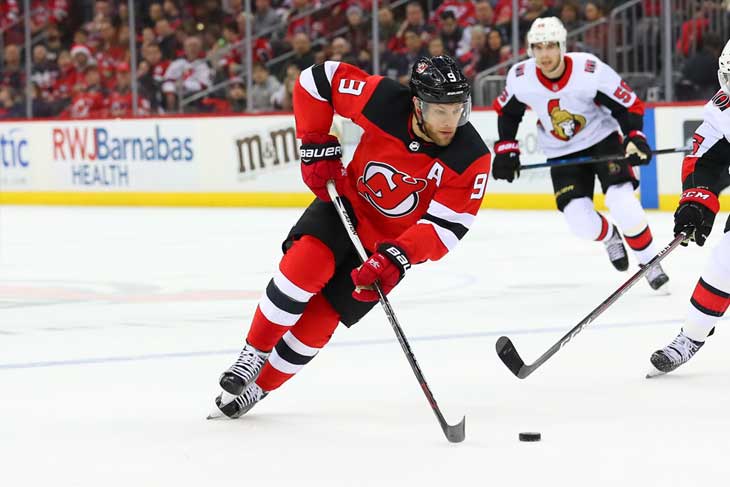2018-19 Season Review: New Jersey Devils
After missing the playoffs in five consecutive seasons, the New Jersey Devils enjoyed a wonderful bounce-back campaign in 2017-18. The team was able to ride its razor-thin margin of victory to the spring tournament because Taylor Hall realized his full potential on the road to a 93-point MVP year. Though the squad had improved with the addition of first overall pick Nico Hischier and a clearer identity, Hall was its trump card. By season’s end, he had built a 41-point gap between himself and the Devils’ next closest scorer.
With that in mind, one might be tempted to attribute last season’s 31-41-10 slide to a knee injury that sidelined him for nearly 50 games.
That narrative doesn’t hold any water, though.
New Jersey would have certainly loved to ice its best player for more than 33 games, but its record prior to his injury (12-16-7) wasn’t worlds removed from its performance without him (19-25-3). The truth is head coach John Hynes’ club suffered a total collapse in the trenches. Despite a system that emphasized preventing high-danger chances, the team conceded its highest goal total since 1992-93. At 5-on-5, the Devils controlled 46.9% of the shot attempts (29th), 47.9% of the scoring chances (23rd) and 51.1% of the high-danger opportunities (15th). More importantly, New Jersey allowed the fourth-fewest high-danger chances in the NHL…and somehow the eighth-most high-danger goals.
While the team shelled up to limit the opposition’s looks from the slot, the last line of defense frequently buckled from that very same area. That’s a recipe for disaster. Many were quick to blame the goaltenders, and Keith Kinkaid (3.36 GAA, 89.1 SV%) and Cory Schneider (3.06 GAA, 90.3 SV%) definitely didn’t do New Jersey any favors with their subpar play between the pipes. Kinkaid made a name for himself with solid outings in 2017-18, but he didn’t come close to replicating that performance last season. Schneider, who once boasted some of the stingiest numbers in NHL history, now resembles a shadow of his former self. He hasn’t hit the mediocre 91.0 SV% threshold in three years, and the unflappable confidence and quiet movement that defined his game have disappeared. These days, he just seems rattled — like he’s praying for pucks to hit him rather than tracking the puck and beating shooters to his spot.
22-year-old Mackenzie Blackwood (2.61 GAA, 91.8 SV%) fared much better in his 23 appearances, which bodes well for the team’s outlook moving forward. As it relates to 2018-19, it was too little, too late: New Jersey ultimately ranked 27th in on-ice SV%.
This doesn’t absolve the defense at all, however. There were simply far too many gaffes in high-percentage areas.
Damon Severson has consistently performed below the team average in shot, chance, high-danger chance and goal shares, and last season wasn’t any different. The 25-year-old set a career high in points with 39, so it’s not as though his production excuses his porous defense. He’s fully capable of refining his game too, but he seems indifferent to the task. Sami Vatanen’s play also slipped following a stellar first year in New Jersey. The undersized blueliner struggled in front of his net and wasn’t assertive enough to direct the action away from his zone. Even when he’s on, he isn’t the type of No. 1 defenseman who can turn the tide on his own. The biggest letdown came from captain Andy Greene. While the 36-year-old’s decline was inevitable, it was steep in 2018-19. New Jersey’s woes in the dirty areas perfectly mirrored Greene’s, as he was downright awful in the trenches. The typically steady veteran couldn’t win his battles at the point of attack and often seemed overwhelmed by skilled opponents.
Hynes was probably at a loss for solutions because the club ranked 15th in expected goals against but 25th in actual goals against. Teams shouldn’t have been as successful as they were against New Jersey, but poor goaltending and lousy coverage conspired to doom the team from the net out.
Hall’s absence and a lack of depth up front meant that the offense wasn’t able to outscore the defensive issues either. Outside of Hischier (47 points in 69 games), Kyle Palmieri (50 points in 74 games) and Travis Zajac (46 points in 80 games), there wasn’t much punch to speak of. In his second year with the Devils, Marcus Johansson (27 points in 48 games) still hadn’t settled in and seemed uncomfortable in a larger role than he filled in Washington. Talented youngster Jesper Bratt (33 points in 51 games) missed about 30 games due to injury. Meanwhile, 2015 sixth overall pick Pavel Zacha (25 points in 61 games), 2016 first-rounder Michael McLeod (3 points in 21 games) and 21-year-old Joey Anderson (7 points in 34 games) still weren’t ready to contribute at the pro level. That left Blake Coleman (36 points in 78 games), Miles Wood (24 points in 63 games), Brian Boyle (19 points in 47 games) and some spare parts to play well above their heads — and only Coleman rose to the occasion. The Devils ultimately registered the 25th-ranked offense.
By the trade deadline, New Jersey had accepted its fate and dealt Johansson and Boyle to contenders. The club finished with the third-worst record in the league, which seemed unfortunate considering the top two draft picks’ franchise-altering potential.
But for the second time in three years, the draft lottery was very kind to the Devils and totally changed their outlook. Their leap to first overall allowed them to pick center Jack Hughes to bolster their top six. Though he carries a slight 5’10”, 170-pound frame, the 18-year-old is a brilliant playmaker who is lethal in space. Moreover, Hischier’s presence should give Hynes the luxury of starting Hughes on the second line. No prospect is a sure thing, but the kid certainly has the right skill set to excel in the speed-oriented modern NHL.
One day later, general manager Ray Shero declared that New Jersey was intent on competing right now by acquiring star defenseman P.K. Subban (31 points in 63 games). Though the 30-year-old’s best years are likely behind him, he remains a dynamic blueliner who can absolutely rip cannons from the point. As long as he doesn’t feel pressured to carry the offense, he should help a blue line that sorely needed reinforcements. On the opening day of free agency, power forward Wayne Simmonds (30 points in 79 games) signed a one-year deal with the team too. Whether or not he can recapture his power play prowess (third in power play goals over the past five seasons), he’s another veteran who can sharpen the team’s competitive nature.
The most significant addition, however, arrived via a less splashy trade: Shero shipped a second- and third-rounder to Vegas for Russian star Nikita Gusev. At age 27, he fits the team’s decision to go all in and isn’t one of those players who spent a few too many years ripening overseas before coming over. He just torched the KHL (82 points in 62 games) and IIHF World Championships (16 points in 10 games) and seems poised to make an Artemi Panarin-esque impact on New Jersey’s forward corps.
Afforded the time to develop chemistry, the Devils could boast a dangerous top six. This newfound depth will also push the glue guys to more comfortable positions and grant Zacha, Anderson, McLeod and 2017 second-rounder Jesper Boqvist the chance to progress at their own pace.
On the back end, 2018 first-rounder Ty Smith is knocking on the door and could provide the team with greater puck-moving balance on the left side. He skates well and displays smart decision-making on the breakout. Even without the 19-year-old in the mix, the revamped forward corps should enjoy much better looks from the blue line next year. Will Butcher has flashed great instincts in the offensive zone, Subban has made a career out of generating offense, Severson thrives with the puck rather than without it and Vatanen is a perfectly serviceable passer.
Of course, this more potent squad won’t get anywhere if Blackwood can’t carry his weight in net. Schneider has become wildly unreliable and Kinkaid signed as a backup in Montreal. Assuming Blackwood can deliver average or better performances, 2019-20 suddenly looks very promising for the Devils.
They haven’t quite stacked the deck this offseason, but they’ve become a whole lot more than Hall & Co. in short order.
Recent Posts

How Corey Perry Is Making His Presence Felt With the Lightning
View Post »
How Adam Fox Pushed the Rangers Past the Penguins
View Post »

 PHI
PHI PIT
PIT TOR
TOR MTL
MTL TBL
TBL CHI
CHI EDM
EDM VAN
VAN COL
COL STL
STL BUF
BUF WSH
WSH NJD
NJD BOS
BOS NYR
NYR NYI
NYI DET
DET CAR
CAR NSH
NSH CBJ
CBJ WPJ
WPJ CGY
CGY ARI
ARI SJS
SJS VGK
VGK ANA
ANA LAK
LAK MIN
MIN OTT
OTT FLO
FLO DAL
DAL